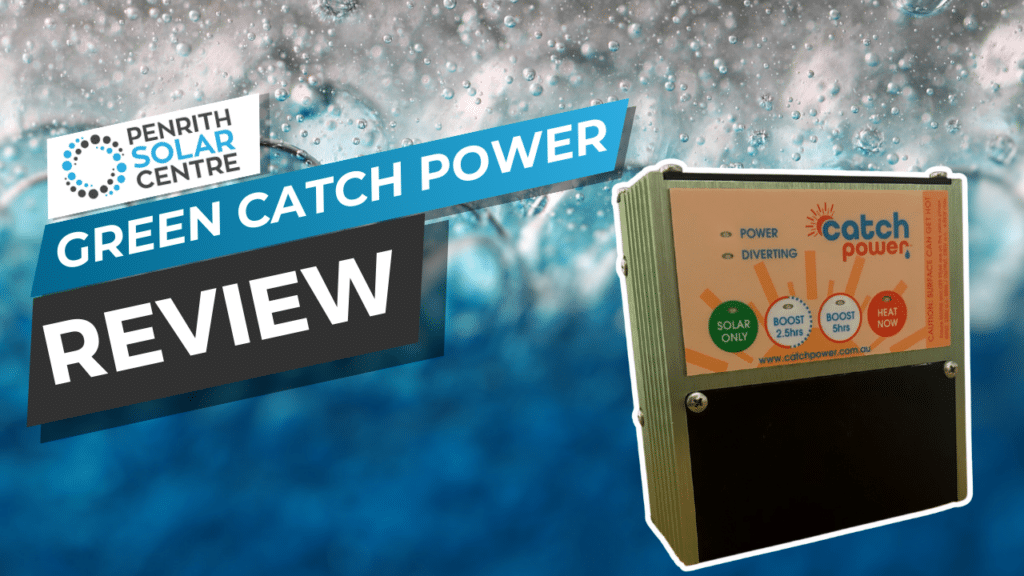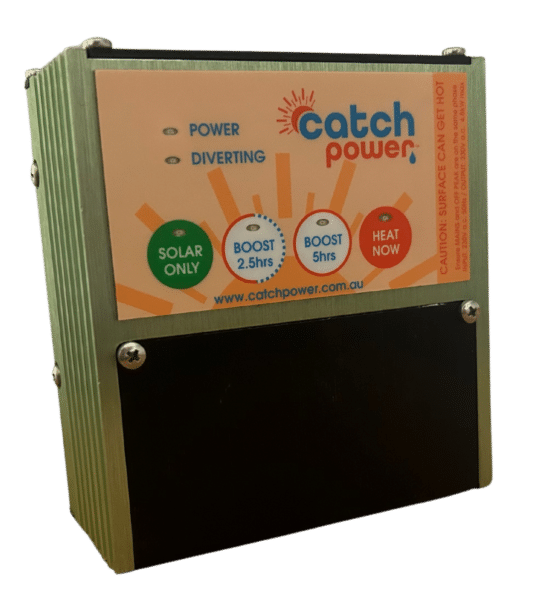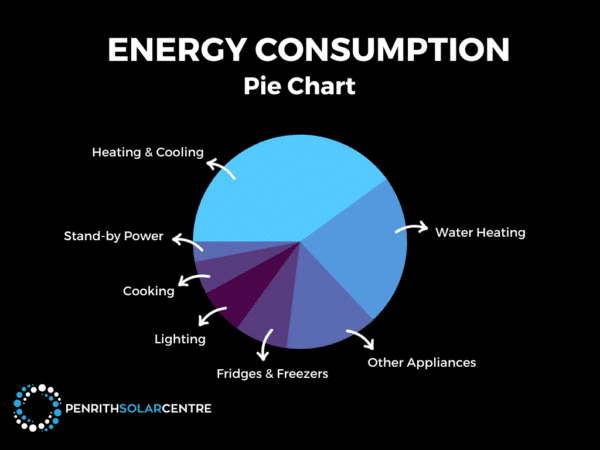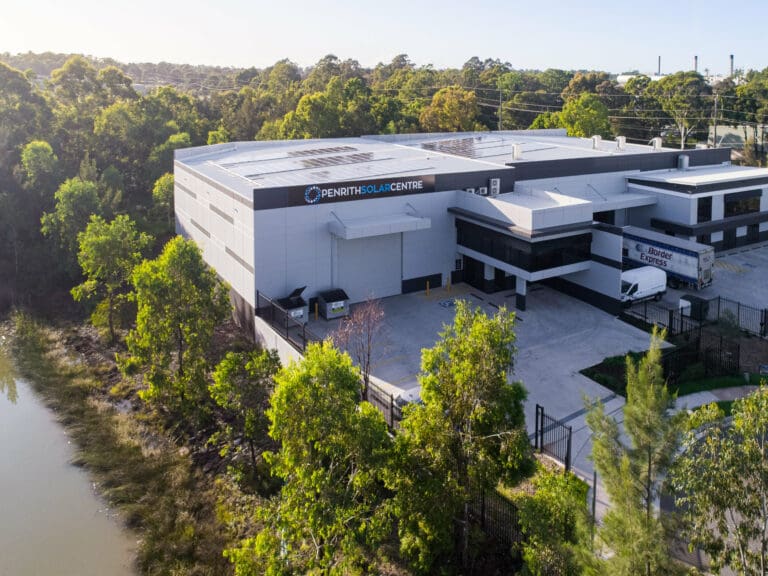
Do you have any idea how much electricity your hot water system needs to function? It’s a lot: between 6 – 10kWh a day (depending on your needs).
But you’re getting solar to eliminate the rising cost of electricity. That should take care of the water heater, right? Well… maybe, maybe not.
You might not be able to get those electricity bills completely zeroed out. You might still be drawing from the grid at off-peak hours in the middle of the night to heat your water. It’s a problem for customers that isn’t always a part of the installation conversation.
At Penrith Solar Centre, we want you to understand every step of the installation process. We want you to be an informed shopper, empowered to ask the right questions regardless of who you choose to install your solar system. We offer Green CATCH Power for customers who skip installing a solar battery, so we are a bit biased about this product. This review, however, will dive into the nuts and bolts of what Green CATCH Power is, why you might want it, and how it will affect your electricity bills.
In this article, you will learn:
- What is Green CATCH Power?
- Why Would You Install Green CATCH Power?
- What are the Pros and Cons of Green CATCH Power?
- Who is Green CATCH Power a Good Fit For?
- Who is Green CATCH Power a Bad Fit For?
By the end of this article, you’ll understand what Green CATCH Power is and why you might want to talk to your installer about it as an option for your solar system.
What is Green CATCH Power?
Green CATCH Power is a hot water diverter that guides the electricity from the solar panels to go into the hot water system rather than getting sent to the electrical grid for a feed-in tariff.
That’s quite a mouthful. Let’s break that down into less technical terms.
Green CATCH Power is a small device that mounted into the main switchboard.

Most solar batteries can manage electricity between the home and the grid. For customers who don’t want a solar battery, Green CATCH Power is a solution.
A solution to what problem?
When most folks start their solar journey, they think that if they get solar on the roof it will eventually pay for itself and eliminate electricity bills. That is absolutely possible.
The energy required to heat the hot water system is significant. 6kWh – 10kWh is a lot of electricity. In most residences, that electricity comes from the grid in the middle of the night when it’s the least expensive.
Green CATCH Power catches (see what they did there?) the electricity from the solar system before it goes back to the electrical grid for a feed-in tariff. It diverts the power to the hot water system. This can save you money by not drawing power from the grid in the middle of the night to heat the hot water system.
The hot water system is fed by the grid during the night when electricity costs considerably less (we’ll have examples to illustrate this point shortly). On your electric bill, that cost is often grouped with the cost of electricity for all other appliances during all other times of the day when electricity is more expensive.
We have customers come to us who only see one price for their electricity and are surprised when members of our team evaluate their energy needs and find this type of additional charge on their bill.
It might come as a surprise to see additional electricity charges once you’ve installed a solar system. We really want to avoid that from happening.

When you start to look at energy consumption and storage, you start to see your resources differently. How much it costs money to buy electricity to keep your hot water system warming all that wonderful hot water. It’s just redirected energy.
Think of your hot water system as a battery. It stores electricity that’s been converted into heat. The only way it’s different from your Tesla Powerwall 2 is that the material (water) that contains the converted energy.
Why Would You Install Green CATCH Power?
A little bit of math should help determine if Green CATCH Power is a logical financial investment for your home.
In Penrith, a suburb of Sydney in New South Wales, there are several electricity retailers to choose from for your energy needs. We looked at one of them.
The peak hour rate, off-peak hour rate, and feed-in tariff listed below are not fixed rates, they change with the market. So don’t be surprised if you find something different in your own research. For the purpose of this example, this is what we were quoted:
- Peak Time (1pm to 10pm) — $0.38 per kWh
- Off-peak Time (10pm to 7am) — $0.18 per kWh
- Feed-in Tariff — $0.07
For the sake of making the math simple, let’s say you have a 5kW system on your roof, which can generate 18kWh of electricity per day. Your energy consumption for household appliances is 14kWh a day and you’re exporting 4kWh back to the grid for a feed-in tariff because you don’t have a solar battery.
If you need 4kWh of electricity to heat your hot water during off-peak hours, you’d be spending $0.72 per day. Which is $5.04 per week, $20.16 per month, and $241.92 per year.
If your solar system is outputting those 4kWh back to the grid instead of diverting it to the hot water system, you’re making $0.28 per day. Which is $1.96 per week, $7.84 per month, and $94.08 per year.
If your solar system was able to divert that electricity using Green CATCH Power, you would be saving $241.92 per year in electricity bills.
The feed-in tariff added up over a year is only $94.08 total. It’s considerably less money and isn’t really an economical option.
Green CATCH Power costs $970 at Penrith Solar Centre. Using this example, it would pay for itself in about 4 years. Your solar system’s output and energy rates will differ from this example though. Like so many situations in the solar industry, the exact figures depend on your needs, which will be unique to each home and household.
But remember, the cost of electricity is rising.
If you’re interested in learning more about how we work with you in evaluating your energy consumption needs, feel free to check out the following article titled, In-house Installers vs. Subcontractors: Which is Better?
What Are the Pros and Cons of Green CATCH Power?
While Green CATCH Power might sound like a helpful product (and for some, it is), it’s not necessarily for everyone.

Here are some pros and cons:
Pros
- It’s a cost-effective solution that contributes to the efficiency of your solar system, allowing for greater usage of your solar power.
- It reduces hot water costs.
- It’s easy to install.
- It can be installed after your solar goes up and uninstalled if you want to retrofit a battery to your system.
- It’s compatible with most solar systems.
- It has a comprehensive 5-year warranty.
Cons
- It’s useless if you have or want to install a solar battery.
- It’s an additional $970 to your system.
- Your solar system will not always heat your water for you. There are cloudy days when the solar isn’t producing enough to power everything. You still might have periods of time where you’re going to need to still get your electricity from the grid. It still works within the limitations of your solar system.
Who is a Good Fit for Green CATCH Power?
Green CATCH Power is a great fit for some customers.
- If you’re not going to invest in a battery or are considering investing in a battery later, then Green CATCH Power is a great option. You can always uninstall it when you’re ready to upgrade your solar system with a battery.
Solar batteries can cost quite a bit. It’s an investment that some shy away from because of the upfront cost. If you’re interested in learning more about why you might want to consider a solar battery with your solar, you might want to check out the following article titled, 7 Considerations for Choosing a Solar Battery.
Find Out About Solar Batteries!
Who is a Bad Fit for Green CATCH Power?
Green CATCH Power is not a good fit for everyone. Here are some situations where you might want to avoid it.
- If you have a solar battery installed with your solar system, you will not need Green CATCH Power. The diverter and the solar battery will fight for control of your electricity, much like the epic Toho Films face-off between Mothra and Godzilla in the film Mothra vs. Godzilla.
- If you have a particularly small switchboard, your installer might not be able to find room for it. Tight switchboards might not accommodate it.
- Honestly, it’s important to look at your electricity bill with solar. It might take you a while to see a return on investment with Green CATCH Power depending on your energy consumption patterns. $970 isn’t exactly cheap, and financially, it isn’t a good fit for some households.
The Final Verdict on Green CATCH Power
You are now an expert on all things related to this hot water diverter, why you might want it, and what advantages or disadvantages it might have for you. When you think of your hot water system as an energy storage solution (a battery), you’ll see why there are possibilities for you home with this piece of equipment.
If you don’t invest in a solar battery, Green CATCH Power might be a good fit for you when it comes to powering your hot water system. However, it’s a paperweight if you’re going to install a solar battery with your solar system because the two components will fight each other for control of how your electricity is directed.
At Penrith Solar Centre, we’re committed to educating you about the different technologies that will enhance your solar journey. We’re also here to help you determine what will work best for you based on your energy consumption patterns and individual needs. Every household is unique, and every solar system is tailored for that purpose.
If you’re interested in reading more about how you can upgrade your solar system with a solar battery, we recommend you investigate this article titled, Enphase IQ Battery 5P vs Tesla Powerwall 2: Which is Right for You? Happy shopping!










